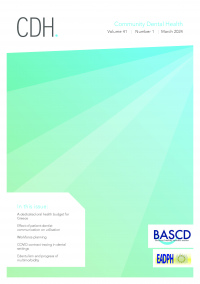September 2009
A comparison of Personal Dental Service (PDS) and General Dental Service (GDS) patients in terms of reported interventions, oral health and dentists’ perceptions
Abstract
Aims: The aim of the study was to investigate the reported working patterns, dentist perceptions and patient oral health for dentists in a Personal Dental Services (PDS) pilot and compare this with that of matched dentists working in the General Dental Services (GDS) arrangements in the same part of England. Method: Ten dentists were recruited, five each from PDS and GDS practices in Warwickshire, UK. The number of interventions carried out for adult patients in the year to April 2003 was obtained from the Dental Practice Board (DPB) for the two groups and compared. An Oral Health Index (OHX) (Burke and Wilson, 1995) was used to determine the oral health of a selection of patients from the two groups of dentists in the study. The final stage of the study involved semi-structured interviews with the dentists. Results: The average age of dentists was similar, in the early to mid 40’s (p>0.05). Both groups were, on average, around 20 years post qualification. The GDS dentists made an average of 3,507 activity reports to the Dental Practice Board in the year examined, compared with 3,441 from the PDS dentists. PDS dentists provided fewer simple periodontal treatments than GDS dentists, but otherwise the pattern of reported activity was similar. Both PDS and GDS dentists suggested that GDS dentists carried out more fillings because of a perverse incentive to provide fillings compared with PDS arrangements. PDS dentists believed that their treatment profiles had not changed significantly since changing to PDS, and suggested that their prescribing was based on clinical need only and was not influenced by the remuneration system. A total of 225 OHX scores were obtained for patients attending PDS dentists and a further 214 from patients attending GDS dentists. Overall, the mean OHX score was lower in the GDS patients than for PDS patients. Conclusions: PDS dentists provided fewer simple periodontal treatments than their GDS counterparts. There was no difference in the oral health of patients treated under either system. Although there was some evidence of a difference in attitude between GDS and PDS dentists towards charging and claiming for simple periodontal treatment, there was no uniformity of opinion within either group. There would appear to be a number of complex factors impacting upon decisions to treat or monitor dental conditions. Key words: Attitudes, dental services, GDS, oral health index, PDS.




